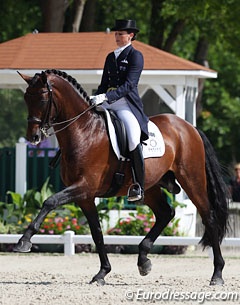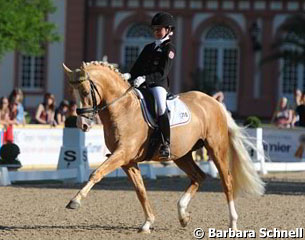
With geldings taking out gold, silver and bronze at the 2012 London Olympic Games, it seems that the demands of competitive dressage as well as the added safety benefits are encouraging horse owners to castrate their dressage partners.
"I don't know if the process of castration is becoming more common," says Tom Schell DVM. “But certainly overall it is a common procedure, performed most typically when the stallion is not going to be used for breeding."
According to Dr Schell, stallions are castrated primarily for behavioral reasons, as it helps to lower their levels of testosterone in the blood stream, thus reducing their innate desire to breed. "This leads to a more manageable animal, as well as a more focused one."
Former British team rider Wayne Channon agrees, saying that unless the horse is going to be a breeding stallion he would always recommend castration. "The reason for this is that they are much more relaxed at home, with other horses and at shows. They have a more sociable life. Additionally, in my experience, they are easier to train. I think this comes from the fact that whilst a gelding argues, it is not as testosterone driven, so the argument diffuses more quickly.
Adding that this does "not at all" affect their dressage performance, Wayne says he has used full castration and temporary chemical castration on several horses and they all performed just the same as when they were stallions.
"I prefer geldings to train and ride. Any horse may be argumentative, but if you add testosterone to an already argumentative horse you create an explosive situation. Geldings seem to be easier to get along with."
Having worked with a lot of both stallions and geldings, Wayne stated that in his experience castration significantly reduces a stallion's aggression. "This leads to horses that are more easily trained, more easily handled, that can live with other horses more sociably, that still perform just as well and that, in general, seem happier."
 Former Olympic individual medalist Sven Rothenberger also highlights the ease of sociability of geldings compared to stallions, particularly during his years of experience in pony dressage.
Former Olympic individual medalist Sven Rothenberger also highlights the ease of sociability of geldings compared to stallions, particularly during his years of experience in pony dressage.
"The effect of castration always depends on the pony," says Rothenberger. "But if I have to say something in general then I would say stallions are more difficult for young pony riders than geldings, as they are more interested in the environment and especially in other mares. In addition, when you transport the ponies you have to take care that there is enough space between them and that they cannot touch the other horses. I´m not sure whether or not competition ponies should be gelded. But if you consider the time after their sporting career, it is much better for the pony to be a gelding, because then they can go out with other ponies for retirement on the fields."
Carried out under sedation the procedure of castration can be performed in a standing or recumbent manner. However Dr Schell prefers the latter option.
"In our practice, I have always performed the procedure in recumbency, which means that the horse was under anesthesia and sleeping for a short period of time. Once sedated or anaesthetized, the testicles are exteriorized via an incision, ligated, cut and removed. In most cases, the incision is left open to drain and heal over the next couple of weeks."
While clearly not the most pleasant experience, Dr Schell says that nothing about the horse really changes immediately following the castration, but that in the long term the procedure can be very worthwhile, particularly in competition.
"The overall goal is to reduce the animal's natural desire to breed or become aroused around mares, as well as to be more manageable in general. Most stallions are gelded between 6 months and 2 years of age, due to the increased ease of the procedure, as well as the lower overall tissue testosterone levels at this age. The longer one waits to geld a horse, the higher the tissue testosterone levels and the less overall impact on its behaviour."
Confirming that this does not in any way affect the movement or conformation of the horse, Dr Schell stated the only real downside is that the horse may be a little sore in the groin region for a week or so post procedure.
 “The procedure does not, at least in my opinion, make the horse any less appealing, although some may feel that a stallion has more energy or enthusiasm as compared to some geldings. However the benefit of a more manageable horse, as well as a potentially safer animal, is definitely something to consider.”
“The procedure does not, at least in my opinion, make the horse any less appealing, although some may feel that a stallion has more energy or enthusiasm as compared to some geldings. However the benefit of a more manageable horse, as well as a potentially safer animal, is definitely something to consider.”
Without a doubt in his mind that the procedure makes the horse easier to handle, Dr Schell says that when a stallion serves it further drives or stimulates his testosterone secretion, and thus reinforces the typical stallion behavior.
“A stallion will return to normal anywhere up to an hour post breeding. However the stallions behavior and recovery time in regards to breeding is very much dependent on their physical condition. Most stallions are relatively reserved immediately post breeding a mare and are very manageable at that time. Long term stallions can however have hock and back issues, but then again it depends whether you are planning on actually competing an active and proven stallion? In terms of the stallion like behavior -- discipline and control -- from the handler's standpoint is crucial to maintain control and safety over the animal."
Finally regarding castrating and competition, Dr Schell added his personal preference which is that "a gelding makes for a better competitor as they are more focused mentally," but he knows that some people prefer a stallion.
by Sarah Warne
Photos © Astrid Appels - Barbara Schnell
Related Links
FEI to Accept Morphine as Controlled Medication
Trakehner Stallion Latimer Gelded and Out of German Young Riders Team
D-Day Retired from Sport
Blue Hors Cavan Castrated
Curator Castrated
Solos Carex Retired from Competition